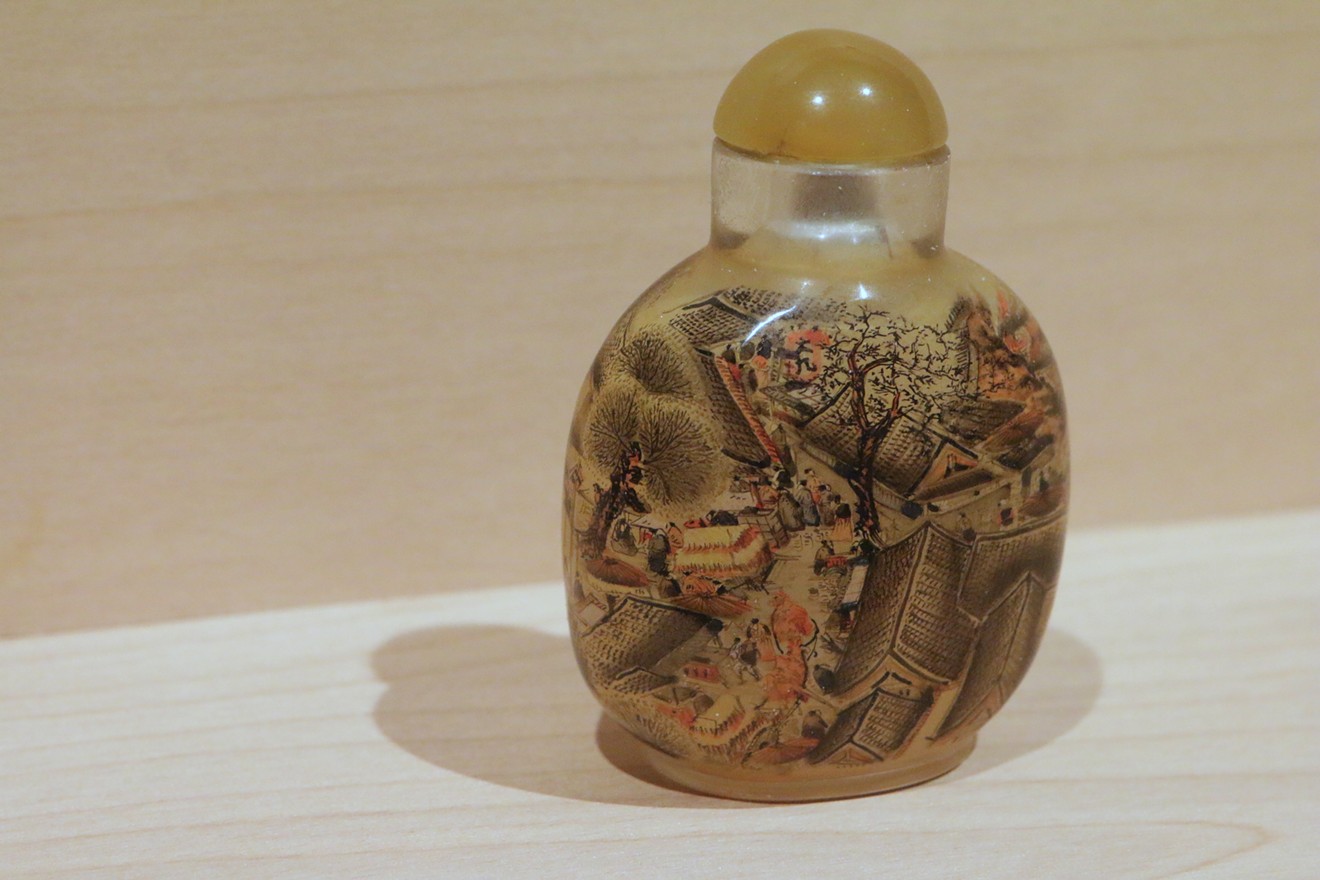Just a few feet from the Phoenix Art Museum’s highly publicized “Legends of Speed” race car exhibition is a much different and less familiar collection of objects.
“Crickets, Tea, and Snuff” is a celebration of small, idiosyncratic objects from the East that function as a window into the fleeting pleasures that colored the daily lives of people on the other side of the world centuries ago.
The exhibition focuses on three beloved mainstays of Chinese culture: drinking tea, sniffing tobacco, and owning crickets. There are glass bottles with tiny, intricate scenes painted on their insides, ornate “arenas” for cricket-fighting matches, and contemporary teapots with life-size animals carved into them.
The museum’s Curator of Asian Art, Janet Baker, sees the primary goal of her job as “introducing Asia to Arizonans” by presenting artifacts that — like sports cars — are meant to be used. The Chinese used all of these hobbies as a way to communicate their high status.
Tobacco made its way to China in the 16th century. Back then, they liked to sniff it. The snuff bottles in the collection are made of agate, jade, lapis, and even meticulously painted glass. These are particularly impressive, featuring ultra-detailed scenes painted from the inside with tiny brushes. Today, although smoking is rampant in China, hardly anyone uses snuff. That is not the case for the other pastimes the exhibition shows off.
For thousands of years, the Chinese people have practiced cricket ownership — largely for the benefit of the sounds the insects make. Their cages, which are on display at the museum, are pocket-sized. Some are made from gourds and feature impressive designs, either carved in or made through a process in which a seedling is dropped into a mold, causing the container to grow organically with decorative markings.
There is an appeal to cricket ownership beyond the chirping, however. Cricket-fighting is an active Chinese tradition with a 1,500-year history. Today, high-level trainers scour the countryside for specimens and feed their prizefighters premium ingredients in accordance with 1,000-year-old guides. In 2010, a study found China spent $63 million on cricket sales and upkeep. The exhibition’s 200- to 300-year-old cricket-fighting “arena” is a reminder of the old roots of this curious pastime.
Like crickets, tea is serious in China. And the 2,000-year-old city of Yixing has made its name through its renowned “teaware.” The place’s clay is devoid of all dangerous and taste-altering elements like lead and arsenic and is porous in such a way that it soaks up the flavors of all the batches brewed with it, like a cast-iron skillet. This effect is so pronounced that serious tea-drinkers only brew one type of tea with each Yixing pot and never wash it with soap.
All of the teaware on display at the exhibition is from this eastern Chinese city. The geometric and naturalistic designs are a testament to the ingenuity of a small but prolific powerhouse of production.
The exhibition, which will remain open until March, is composed entirely of objects in the museum’s permanent collection. Everything on display was donated by four enthusiastic Phoenician collectors: Amy S. Clague, William and Deborah Carstens, and James T. Bialac.
Baker says these things are related because they all give rise to “ephemeral pleasures,” so we can relate to the exhibition’s objects and the practices they imply. Fancy cars communicate status, and fine flowers rot after days. We pay for one-off musical festivals and small cups of single-origin coffee.
“It’s not another planet,” Baker said of China. “It’s just the other side of this one.”
[
{
"name": "Air - MediumRectangle - Inline Content - Mobile Display Size",
"component": "18478561",
"insertPoint": "2",
"requiredCountToDisplay": "2"
},{
"name": "Editor Picks",
"component": "16759093",
"insertPoint": "4",
"requiredCountToDisplay": "1"
},{
"name": "Inline Links",
"component": "17980324",
"insertPoint": "8th",
"startingPoint": 8,
"requiredCountToDisplay": "7",
"maxInsertions": 25
},{
"name": "Air - MediumRectangle - Combo - Inline Content",
"component": "16759092",
"insertPoint": "8th",
"startingPoint": 8,
"requiredCountToDisplay": "7",
"maxInsertions": 25
},{
"name": "Inline Links",
"component": "17980324",
"insertPoint": "8th",
"startingPoint": 12,
"requiredCountToDisplay": "11",
"maxInsertions": 24
},{
"name": "Air - Leaderboard Tower - Combo - Inline Content",
"component": "16759094",
"insertPoint": "8th",
"startingPoint": 12,
"requiredCountToDisplay": "11",
"maxInsertions": 24
}
]













